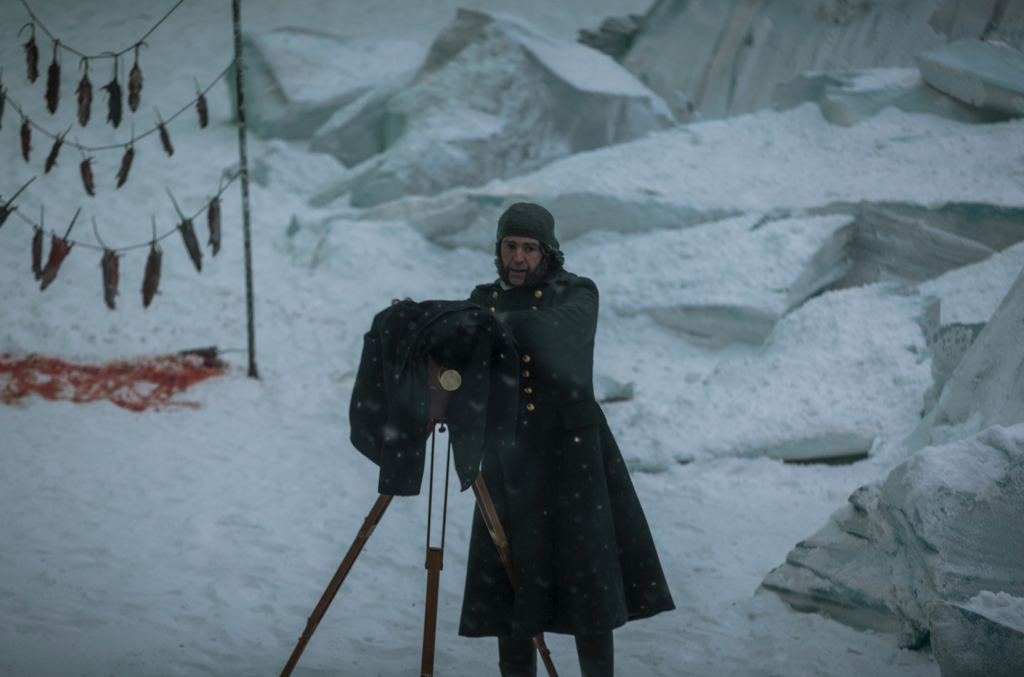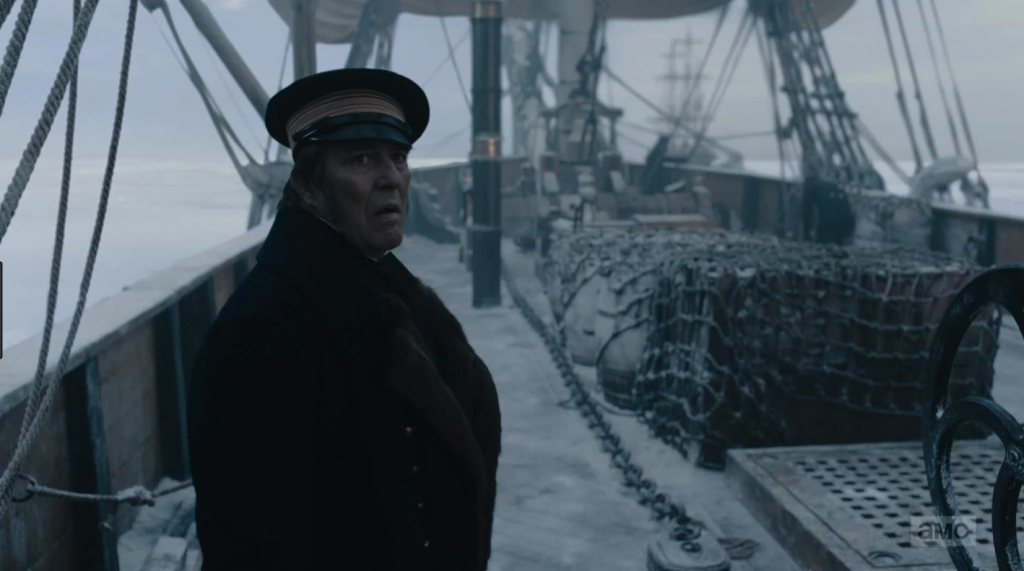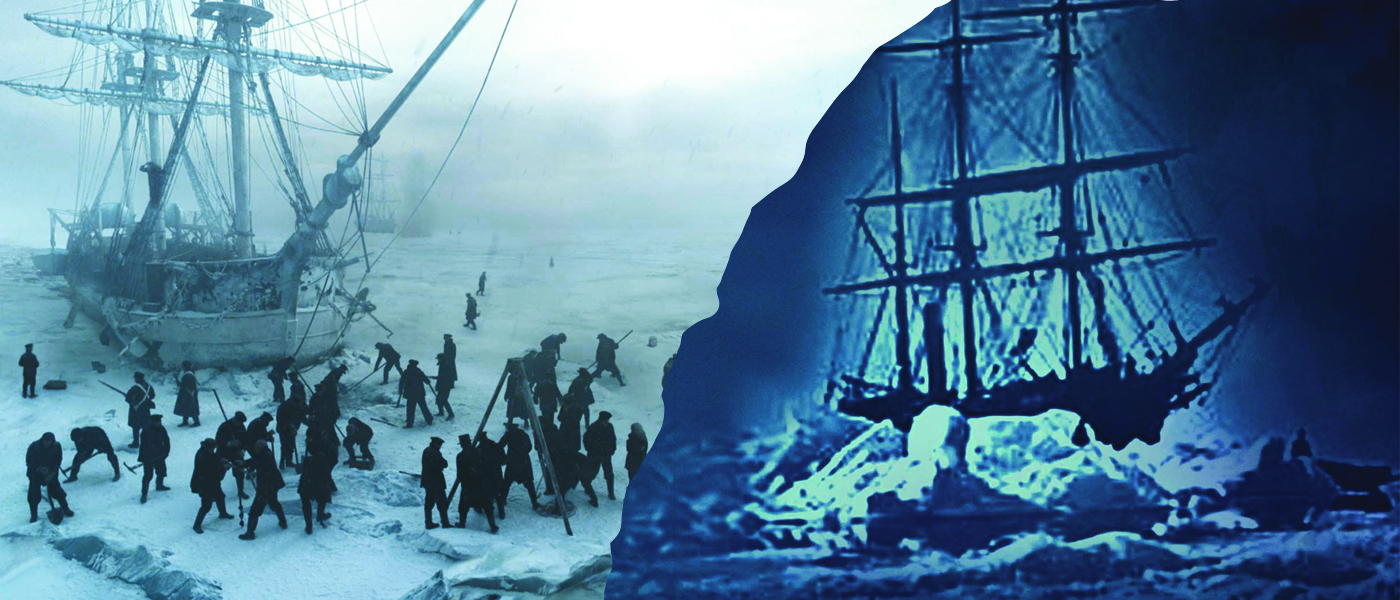In 1845, two vessels of the Royal Navy, the HMS Erebus and the HMS Terror, under the command of Captain Sir John Franklin, set out on a perilous, arctic expedition to locate and chart the illusive Northwest Passage. Those ships never returned. American author Dan Simmons’ 2007 novel, named after the latter vessel captained by Francis Crozier, combines what is known of the ships’ fate with his own fictionalized account of what may have been. The novel was adapted into an AMC television series of the same name in March of 2018. When Erebus and Terror quickly become frozen in hundreds of miles of uncharted sea ice, their crews must survive not only the extreme cold, starvation, and illness, but a mysterious beast intent on hunting and killing off the men until none remain.
First and foremost, the decision to adapt this seven hundred eighty-four-page novel into a ten-episode television series instead of an hour and a half-long movie was not only wise, but absolutely critical. And while the show was, for the most part, a brilliant and comprehensive adaptation of the novel, it was, by no means, perfect. As is true of most film adaptations, the timelines were a bit off. Names were interchanged, deaths took place sooner or later than they should have, etc. None of these minor details distracted much from the overall story, however, there were a few notable changes that left me more baffled than anything. The first of these differences was the Thing on the ice.

In the novel, the first encounter with this strange creature occurs when Sir John Franklin sends several scouting expeditions out onto the ice in search of open water. One of these crews, lead by Lt. Graham Gore is beset upon by a large monster that seems to rise up out of the ice and surround Gore, crushing him to death. The monster is described as polar bear-like, although far more massive, with a triangle-shaped face and two small, black eyes. When the creature appears, a wave of foul carrion-breath can be smelled by those unlucky enough to be in close proximity. The on-screen representation of this creature, however, is far less impressive. Resembling a slightly larger polar bear with oddly human facial features, this beast is shown far too often and in too much detail. Its odd, loping form is reminiscent of the poor CG polar bear effects in ABC’s Lost. The novel paints this beast as an unkillable, entity. A deadly menace to all who face it. A being that renders its enemies completely powerless. Although still responsible for endless wanton destruction and carnage, the visual representation leaves something to be desired in terms of a fear-inducing presence.
Another element I found particularly unique about the screen adaptation was the fact that it tended to shy away from romance and sexuality in places the novel certainly did not. While the show did an excellent job portraying the subtle and intricate fondness between former lovers Henry Peglar and John Bridgens, it skewed and twisted the manipulative affair between caulker’s mate Cornelius Hickey and the idiot giant Magnus Manson. The show also completely ignored the eventual partnership of Captain Crozier and Lady Silence, choosing to portray Crozier as a hopeless romantic stuck on his past fling with the niece of Captain Sir John Franklin. Whether it was a timing issue or a conscious choice, the latter example changed the show’s ending in a major way.

The most puzzling difference between show and novel was the manner in which the show’s ending completely deviated from the book. Up until this point, only minor changes had been made to the overall story. The novel’s ending pulls quite a bit from native lore to explain the presence of the mysterious beast and to bring Crozier and Lady Silence together as the sole survivors of this ill-fated expedition. The show, on the other hand, rather brusquely puts an end to the story of the beast, and presents no explanation as to its origins. While this may not bother those who choose to enjoy only the show, it is a strange approach to those familiar with the novel’s ending. As someone who was lukewarm on both endings, I can understand the show’s desire for a clean wrap-up. Their ending ties a neat bow around the story, and avoids any possibility of cultural insensitivity. The novel’s ending, while a bit long and out of place, did include a scene in which Crozier, returning to his long-lost ship Terror, finds closure once and for all. This scene would have given the show a greater sense of finality, both visually and emotionally.
Whether you have chosen to consume the novel, the show, or both, The Terror is a gripping tale of adventure, stomach-churning dread, and incredible loss. It is a fascinating character study, which presents an extremely compelling look at human resilience, despite unimaginable suffering, in the most hopeless of situations. This is, by no means, a “fun” story. You will watch the people you have come to revere die, in the most tragic and agonizing ways you can possibly imagine. The reader/viewer is denied the mercy of seeing the characters they love triumph over their circumstances.
So then why? Why subject yourself to such misery? Why embark on this voyage knowing, historically, it was doomed from the start? The simple answer is, because of the journey.
Frankly, I’m a bit of a masochist when it comes to my media consumption. I live for the crushing despair of a good tragedy so I can bask in the melodrama of my own anguish. Nothing fulfills me more than feeling personally tormented by a work of fiction. Feed it to me slowly, like grapes. For a piece of literature or digital media to stir something so deep within you that it creates such a visceral, empathetic reaction, it takes a truly skilled storyteller. These characters, people who truly existed, even in name alone, became my own crew, my friends, my brothers, my sons. I felt Crozier’s deep sense of loss when orders were given to abandon ship. I clutched my chest as Jopson was abandoned, left alone to die on his thirty-first birthday. I wept as Blanky, realizing the gravity of his injuries, wandered away from his crew to face the Thing on the ice once and for all. And more than anything, I felt cold. So deeply cold.



